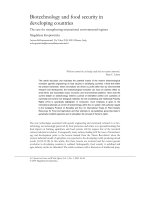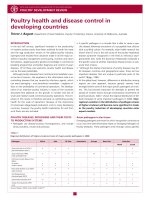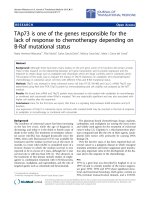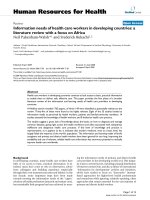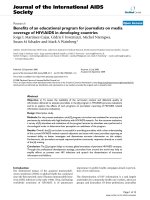Studies on in vitro micropropagation in banana
Bạn đang xem bản rút gọn của tài liệu. Xem và tải ngay bản đầy đủ của tài liệu tại đây (378.87 KB, 10 trang )
Int.J.Curr.Microbiol.App.Sci (2018) 7(7): 3366-3375
International Journal of Current Microbiology and Applied Sciences
ISSN: 2319-7706 Volume 7 Number 07 (2018)
Journal homepage:
Original Research Article
/>
Studies on in vitro Micropropagation in Banana
Alango Kelta, Sunil T. Hajare* and Akilu Banjaw
College of Natural and Computational Science, Dilla University, Dilla (Ethiopia)
*Corresponding author
ABSTRACT
Keywords
Banana, BAP,
Kinetin, Micro
propagation, In
vitro shoot
initiation, Shoot
multiplication
Article Info
Accepted:
24 June 2018
Available Online:
10 July 2018
Banana is one of the important fruit crops and food source for million people in developing
countries. In the study explants (Suckers) of two banana cultivars were cultured on
Murashige and Skoog (MS) medium supplemented with different concentrations of BAP
and Kinetin sole and in combination for shoot initiation and multiplication. The
concentration of BAP alone tested was (0.5mg/l and 1.0mg/l) and kinetin (0.5mg/l and
1.0mg/l) whereas, the combination of 0.5mg/l BAP+0.5mg/l kin and 1.0mg/l BAP
+0.5mg/l kin were used for shoot initiation. For multiplication, concentration of
BAP(2.0,2.5 and 2.5mg/l) alone and in combination BAP+ Kin (1.5mg/l +1.5mg/l,
2.0mg/l +2.0mg/l and 2.5mg/l +2.5mg/l) were used. The rapid shoot initiation obtained
from MS medium supplemented with the combination of 1.0mg/l BAP with 0.5mg/l kin (8
and 10 days) in both Poyo and Giant Cavendish respectively. The highest multiple shoot (
6.0 and 4.5/explants), in Poyo and Giant Cavendish were observed on the MS medium
fortified with 2.5mg/ l BAP+2.5mg/l kin and 2.0mg/l BAP +2.0mg/l Kin respectively. For
root induction 1.5mg/l IBA and 1.5mg/l IAA each tested separately on MS medium. IBA
showed best performance with 5.12 and 4.69 root/ plantlet after four weeks of inoculation
in Poyo and Giant Cavendish respectively. After 12 weeks in vitro plantlets were
transferred to green house for acclimatization where 82% and 88% survival rate was
recorded in Poyo and Giant Cavendish respectively. The two cultivars studied exhibited
variation in shoot initiation, shoot multiplication and rooting. Among the two cultivars
tested Poyo found to be more responsive for in-vitro techniques. It had highest rate of
shoot initiation and multiplication.
Introduction
Ethiopia is one of country which has highly
diverse agro-ecology that can grow different
fruit crops with a vast potential for banana
production (Seifu, 1999; Kahessay et al.,
2010). In Ethiopia the major banana (Musa
paradisiaca var. sapiertum) producing regions
are Southern, Oromia and Amhara (MoA,
2011). Researcher reported that the different
banana cultivars include Giant cavendish,
poyo and other grown in South Ethiopia.
Despite of these potentials, the overall
production amount includes its productivity
and quality is still low. According to CSA
(2014), banana crop in Ethiopia in terms of
area coverage is highest compare to other fruit
crops i.e. 53,956.16 ha with production of
3366
Int.J.Curr.Microbiol.App.Sci (2018) 7(7): 3366-3375
4,782,510 quintals. The global share of
Ethiopia in banana export was only 0.02%
during 2011 which could be indicated to
problems linked with low production and poor
quality to meet standards of the export
international market. By considering this
produce rapid production of banana plantlets
through tissue culture is need of hour.
In traditionally banana plants are propagated
vegetatively by suckers which grow from
lateral buds originating from corms, and
suckers are separated for production of
individual plants. In some instances, complete
or spitted corms with one or several buds are
used. Conventional vegetative multiplication
of banana has been found to express several
negative impacts including, low production,
transmission of diseases and poor preservation
of original plant genetic material (Ngomuo et
al., 2014). Therefore the application of various
biotechnological approaches has become an
integral part of the banana industry now days
(Vuylsteke, 1998). Hence, in vitro culture
technology is proved as best alternative for the
production of large numbers of planting
material of banana in shorter time, lesser
space, disease-free plants and adequate
germplasm preservation.
Based upon earlier scientific reports, only 5 to
10 suckers can be obtained from a banana
plant per year by conventional method.
Furthermore, banana production becomes
seriously affected by different bacterial, fungal
and viral diseases (Rahman et al., 2004). The
major cause of low banana production in
Ethiopia is the complex of foliar diseases,
nematodes, viruses, and insect pests (Seifu,
2003). The insect pests (fruit flies) and
diseases (Banana xanthomonas wilt and
Fusarium oxysporum) are major challenges
for banana production in Ethiopia (Mekonin,
2014). The considerable yield gap of banana is
the widespread use of infected planting
materials (sucker) by different pests and
diseases. Additional using only traditional
propagation (suckers) method of banana is a
major barrier to get enough plant materials
and very difficult to carry bulks volume of
suckers from one place to other. These
conditions have been ended the banana
production below actual potential per hectare
and along with the quality very poor. This
resulting yield loss makes banana an
expensive commodity for consumers which
reduce the cash earnings of producers as well
as the potential of the crop to contribute to the
food security of rural households (Qaim,
1999). To solve these challenges tissue culture
technique is better alternative. Plant tissue
culture (PTC) technique also has great
potential as a means of vegetative propagation
of economically important species, especially
for those difficult to propagate by
conventional methods like seeds or cuttings
(Mohamed, 2007). The numbers of countries
in the world like France (Cote et al., 1990),
Australia (Drew and Smith, 1990), Israel
(Israeli et al., 1995), Cuba and many East
African countries like Uganda, Tanzania and
Kenya (Abraham, 2009) are using in vitro
multiplication of banana. To ensure an
extremely rapid rate of multiplication, tissue
culture
technique
has
definite
and
indispensable advantage over the conventional
method. This technique is independent of
season due to controlled conditions and
requires limited quantity of plant tissue as the
explant source (Arinaitwe C et al., 2000).The
production of plantlets using in-vitro plant
tissues culture techniques could be an
effective for providing disease free and
enough planting materials of banana.
Therefore applying tissue culture technique
widely in Ethiopia is an excellent alternative
to overcome the obstacles, which reduce the
production and quality of banana. By keeping
in view the aforementioned prelude the
present investigation is designed to
development of the efficient in vitro
regeneration protocol in popular Ethiopian
3367
Int.J.Curr.Microbiol.App.Sci (2018) 7(7): 3366-3375
banana varieties
Cavendish.
i.e.
Poyo
and
Giant
Materials and Methods
Study area
The study was conducted at Areka
Agricultural Research Center’s unit of plant
tissue culture. Areka is one of reform town in
wolaita zone. It located south to capital city of
Ethiopia and about 299 km far from Addis
Ababa, Ethiopia.
Preparation of explants
The explants were selected from the field of
Areka agricultural research center. Very
young sucker about three months old was used
as explant in this experiment. The selected
suckers carefully removed from mother plants.
The suckers’ size reduced up to 2-3cm length
and 1-2cm width at base.
Surface sterilization
The prepared suckers were dipped in 70%
ethanol for 60 second. After this it was
washed with distilled water and surface
sterilized with 2% sodium hypochlorite
solution for 20 minutes with few drop of
Tween 20. The Tween 20 used to aid the
surface sterilization more effective because of
its wetting characteristic. Then the explants
(sucker) washed with double distilled water to
remove the trace of chemicals. These surface
sterilized explants trimmed to 1-2cm size and
inoculated under clean conditions.
Experimental treatment and design
In this study, MS medium (Murashige and
Skoog, 1961) was used for shoot initiation as
well as shoot multiplication. For shoot
initiation BAP (MS + 0.5 and 1.0mg/l) and
Kinetin (MS + 0.5 and 1.0mg/l) tested
separately and in combination of BAP and
Kinetin (0.5+0.5 and 1.0+0.5). Whereas, for
multiplication higher concentration of BAP
(MS + 2.0, 2.5 and 3mg/l) in sole and
combination of BAP and kinetin (1.5 +1.5,
2.0+2.0 and 2.5+2.5mg/l) was used. Multiple
shoots were transferred on MS medium
supplemented with two auxins (IBA and IAA)
with the concentration of 1.5 mg/l each for
root induction. All the cultures were
maintained at 22 oC with a light/dark cycle of
16/8 h. White fluorescent light with an
intensity of 120 μmol m-2 s-1 was used for
illumination. After six weeks of inoculation
the rooted plantlets were acclimatized under
green house. The experiment for each
treatment replicated three times. The
experiment was conducted during April 2015
to April 2016.
Data collection and analysis
The data such as number of day required for
shoot initiation, shoot numbers per explant,
shoot length, leaves number per explant, root
number per plantlet and survival rate were
recorded after specific interval of time. The
experiment was carried out with three
replications. The collected data also was
analyzed by using statistical significance two
ways analysis of variance (ANOVA).
Results and Discussion
Effect of different concentration of BAP
and kinetin on shoot initiation
In present investigation, the effects of
different concentrations BAP and Kinetin (0.5
and1.0mg/l), BAP (0.5 and 1.0mg/l) and in
combination BAP + Kin (0.5 +0.5 and
1.0+0.5mg/l) on MS medium were tested for
effective in-vitro shoot initiation in two
varieties of banana (Giant Cavendish and
Poyo). Through all the hormones responded
for shoot initiation all their duration of time
3368
Int.J.Curr.Microbiol.App.Sci (2018) 7(7): 3366-3375
for initiation varied (Table 1). Shoot initiation
started after first week of inoculation on the all
medium tested. But the MS medium fortified
with 1.0mg/l + 0.5mg/l (BAP +Kin) found
highly reactive as shoot initiation within week
compare to rest treatments. For the shoot
initiation, the MS medium fortified with
1.0mg/l BAP + Kin 0.5mg/l proved better as
shoots started to initiates within a week
compared to the rest of the treatments (8 and
10.2 days) in both Poyo and Giant Cavendish,
with higher number of shoots respectively.
These result at par with the findings of
Shagufta et al, (2011) who observed shoot
initiation10.6 days after of inoculation. On
other hand, MS medium with 0.5mg/l kinetin
took almost double time for shoot initiation,
i.e., 19.6 and 20.8 days in Poyo and Giant
Cavendish respectively with low number of
shoots (Table 1). In the present study only the
plant growth regulator (cytokinin) shown
significant effect at alpha (p≤ 0.05) level on
number of day needed for shoots initiation in
both varieties of banana. The BAP proved its
superiority over Kinetin for shoot initiation as
well as shoot length which support the
findings of Khalid et al (2011) who proved the
marked effects of BAP on shoot formation
compared to Kinetin tested in his study. These
results also support the findings of Gilmar et
al (2000), who received more number of
shoots when BAP applied alone compared to
Kinetin. In present study, furthermore, using
BAP combined with kinetin proved best for
shoot initiation (Fig. 1).
Influence of various growth regulators on
shoot multiplication
Among all the treatments, BAP in sole with
the high concentration i.e., MS + 3.0mg/l
produced high number of shoots compare to
other treatment in Poyo and Giant Cavendish
(Table 2 and Fig. 2). Many researchers
recorded multiple shoots on MS medium with
high concentration of BAP (Khanam et al.,
1996; Rabbani et al., 1996; Gebeyehu, 2015).
Response of shoots towards multiplication
varied significantly when growth hormones
supplied in combination. The results indicate
that mean number of shoots was proportional
with concentration of kinetin and observed
highest when both the hormones used in same
highest concentration (2.5 mg/l BAP + 2.5
mg/l kinetin). The maximum mean numbers of
shoots/shoot were 6.0 in Poyo. Whereas, the
same concentration failed to multiply the
highest shoot in another variety i.e. G.
cavedish. In the G. cavendish the MS media
fortified 2mg/l BAP combined with 2mg/l Kin
proved
best
for
multiplication
(4.5
shoots/explants). The source of these
variations may be due to genotype difference
between two cultivars. These results are in line
with the finding of Arinative et al., (2000)
who stated that shoot initiation and
multiplication is cultivar dependent.
MS medium supplemented with BAP
produces multiple shoots in both the cultivars.
Whereas, When BAP used in combination
with kinetin, the rate of shoot multiplication
recorded higher.
In the present investigation, 2.5mg/l BAP
combined with 2.5mg/l kinetin proved best
result (6.0shoot per explants) compare to rest
of treatments for the multiplication in Poyo
after 5 weeks of inoculation (Table 2). These
results are in line with the earlier findings of
Davendra Kumar et al., (2013) who reported
BAP in combination with kinetin is effective
in shoot multiplication. They also recorded
highest numbers of shoots/shoot (5.2shoots) of
Cavendish dwarf variety when inoculated on
MS medium fortified with combination of
BAP and kinetin at concentration (2mg/l and
1mg/l) respectively.
These results are also coinciding with effort of
Azam et al., (2010) who received highest
number of shoot (5.2 per explants) in cultivar
3369
Int.J.Curr.Microbiol.App.Sci (2018) 7(7): 3366-3375
‘BARI-1’ on the MS medium supplied with
combination of 2mg/l BAP with 1mg/l kinetin.
However, in Giant Cavendish, at the same
concentration failed to produce significant
results (Table 2). This may due to genotype as
well as physical difference between Poyo and
Giant Cavendish. Therefore standardization of
concentration of plant growth regulator to
develop efficient multiplication protocol was
very important in these two popular varieties
of Ethiopia. This indicated that optimization in
concentration of plant growth regular very
important in in-vitro micro propagation. In the
present study, the combination of 2.5mg/l
BAP + 2.5mg/l Kin and 2.0mg/l BAP
combined with 2.0mg/l Kin proved better for
poyo and Giant Cavendish respectively.
Giant Cavendish produced less mean number
of shoots compare to Poyo, the highest shoot
recorded were (4.5/explants) which are higher
than the Gebeyehu (2015) who received (3.20
shoots/explant) in the same cultivar on the MS
medium supplemented with media 5mg/l BAP
and 0.5mg/l NAA combination. This variation
might be due to the combination of BAP with
kinetin (Cytokinin) and BAP with NAA
(auxin).
The results of current investigation are
somewhat contradictory with Rabbani et al.,
(1996) who recorded highest number of
shoots/plant (3.11 ± 0.66) with 5.0 mg/l of
BAP and Kin. This may be due to low
concentration of BAP and Kinetin. In the
present study poyo variety was most
responsive, produced maximum number of
shoots than Giant Cavendish. These results are
in agreement with the previous reports on invitro micro propagation on banana cultivars
includes poyo variety (Dagnew et al.,
2012).The cytokinin concentration and
combination shown statistical significant
effect at alpha (p≤ 0.05) level on multiple
shoot number per explants.
Effect of IAA and IBA on root induction
The two concentrations of IAA and IBA have
been tested on M.S medium for root induction.
Root number varied within two concentrations
of IAA and IBA. The results of two
concentrations of auxin 1.5mg/l IBA and
1.5mg/l IAA on root formation after two and
four weeks have been discussed.
Table.1 The effect of cytokinin (BAP and Kin) in sole and combination on number of days took
for shoot initiation
Cytokinin
Treatment
( mg/l)
Kin
0.5
1.0
0.5
1.0
0.5+0.5
1.0+0.5
BAP
BAP+
Kin
Poyo
Day required for Means No.
shoot initiation
of shoot
19.6± 1.16
1.2
16.4± 1.62
1.6
17.6± 1.57
1.4
12.2±1.27
1.8
10.4± 1.88
2.5
8.4± 0.97
3.0
Result expressed as mean ± Std. deviation
3370
G. Cavendish
Day required for Means No.
shoot initiation
of shoot
21.2± 1.31
1.0
18.6± 1.89
1.5
18.4±1.75
1.2
12.6± 1.55
1.5
11.4± 1.55
2.0
10.2± 1.71
2.4
Int.J.Curr.Microbiol.App.Sci (2018) 7(7): 3366-3375
Table.2 The effect of cytokinin(BAP and Kin) in sole and combinations on shoot multiplication
Cytokinin
Treatment
BAP and Kin (mg/l)
2.0
2.5
3.0
MS + BAP + 1.5 +1.5
Kin
2.0+2.0
2.5 + 2.5
MS + BAP
Mean no of shoots
Poyo
2.1±0.54
2.8±0.48
3.2±0.61
3.4±0.72
4.4±0.85
6.0±0.55
G. Cavendish
1.8±0.65
2.2±0.55
2.6 ±0.70
3.2 ±0.39
4.5± 0.76
3.6 ±0.70
Table.3 The effect of IAA and IBA on root induction
Auxin
Plantlets
10
1.5mg/l IAA
10
1.5mg IBA
Mean no of roots/shoots
Poyo
Mean root
Mean root
number after number after
two weeks
four weeks
3.56
4.00
4.12
5.12
G. Cavendish
Mean root
Mean root
number after
number after
two weeks
four weeks
3.00
3.21
4.00
4.69
Table.4 Survival percentage of in vitro raised plantlets
S.
No
1
2
3
4
5
Number of
regenerations
transfer to pots
10
10
10
10
10
Number
survived
Poyo
09
08
09
07
08
regeneration Percent of Survival
G. cvendish
10
90
80
80
90
Poyo
90%
80%
90%
70%
80%
G. cavendish
100%
90%
80%
80%
90%
Fig.1 Shoot initiation in Poyo (A) and Giant Cavendish (B)
A
B
3371
Int.J.Curr.Microbiol.App.Sci (2018) 7(7): 3366-3375
Fig.2significant
Shoot multiplication
in Poyo(A)
Giant
cavendish(B)
statistical
effect at alpha
(p≤ 0.05)and
level
on multiple
shoot number per explants.
A
B
Elongated shoots were transferred to MS
medium containing 1.5mg/l IBA and 1.5mg/l
IAA. The cultures were maintained in 16hrs
light /8hours dark photoperiod which
concluded by biotechnologists show best
result in plant in-vitro micro propagation. The
effect of IAA and IBA on number of roots per
explants
produced
by
standardized
concentration at 1.5 mg/l was found
statistically
significant
(Table
3).
Significantly highest means number of root
was produced at 1.5mg/l IBA (5.12 and 4.69)
in Poyo and Giant cavedish respectively. The
treatment 1.5mg/l IBA produced 5.12 mean
number of roots in Poyo and 4.69 mean
number of roots in Giant cavendish after four
weeks of inoculation.
The vigorous rooting of in-vitro grown
plantlets observed on MS medium fortified
with 1.5mg/l IBA. The present results are in
line with the findings of Gubbuk and
Pekmezci (2004) and Molla, M et al (2006)
who obtained 5.5 number of root per plantlets
on MS medium supplemented with1.5mg/l
IBA. They also recorded 3.89 and 3.93
number of roots on 0.2mg/l IBA and 0.3mg/l
IBA respectively. The results of present
experiment were found similar with findings
of Khanam et al., (1996) (Table 3). This result
not agree with the other researcher who
reported that IBA at the concentration 0.5mg/l
the highest percentage of rooting (6
root/plantlet) was observed in Cavendish
dwarf variety (Davendrakumar et al,
2013).The source of variation may difference
in cultivars variety and concentration of the
auxin.
After four weeks of culture, rooted plantlets
were removed from culture jars and were
washed in running tap water to remove agar
from root surface. Then the rooted plantlets
were transplanted to plastic bag containing
FYM + Soil with ratio (1:1) and were placed
in green house. After 5 weeks the survival
percentage was calculated. The survival rate
of in-vitro regenerated plantlets was about
82% and 88 % for Poyo and Giant Cavendish
(Table 4). These results are in close
3372
Int.J.Curr.Microbiol.App.Sci (2018) 7(7): 3366-3375
conformity with Jasari et al., (1999) and
Shiragi et al., (2008) who recorded 83.3% and
92% survival rate respectively.
On the basis of results obtained from present
investigation, the following conclusions are
drawn.
The two cultivars studied exhibited variation
in shoot initiation, shoot multiplication
and rooting. This may be due to genetic
makeup of two varieties.
Among the two cultivars tested in present
study, Poyo found to be more responsive
for in-vitro techniques. It had highest
rate
of
shoot
initiation
and
multiplication.
BAP alone not effective for shoot initiation
and
multiplication.
Whereas,
combination of BAP and Kinetin was
found most effective for shoot initiation
as well as shoot multiplication.
For rooting IBA showed best performance in
both cultivars of banana.
In hardening the mixture of FYM+ Soil in
ratio (1:1) showed good survival rate in
both cultivars varieties of banana.
Plantlets production through in-vitro plant
tissue culture techniques seems to be
very effective for rapid and large scale
multiplication of banana cultivars. The
Method may also very useful for
commercial production of banana.
Authors’ contributions
This work was carried out in collaboration
between all authors. Authors AK, STH, NMC
and AB carried out all experimental work,
data acquisition and analysis, literature
search. STH was responsible for study
concept, designing and coordinating the
research and supervising the work. Authors
GB and AB contributed to writing and
manuscript preparation. All authors read and
approved the final manuscript.
Competing interests
Authors have declared that no competing
interests exist.
References
Abraham
A.
(2009).
Agricultural
biotechnology
research
and
development in Ethiopia. African J. of
Biotechnology Vol. 8 (25), Available
online
at
http://www.
academicjournals.org/AJB
Arinaitwe C, Rubaihayo P, Magambo M.
(2000) Proliferation rate effects of
cytokinin on banana (Musa spp.)
cultivars. Scientia Horticulturae 86,
13-21
Azam, F.M.S. Islam1, S. Rahmatullah, M.
and
Zaman,
A.(2010).
Clonal
Propagation of Banana (Musa spp.)
cultivar ‘BARI-1’ (AAAGenome,
Sapientum Subgroup). Department of
Biotechnology
and
Genetic
Engineering, Bangladesh Mirpur,
Dhaka-1216.
Cote, F., D. Alvard, R. Domergue, L.N.
Mastache and C. Teisson. (1990).
Micropropagation in vitro du bananier,
Fruits, 45: 112-118.
CSA. (2014). Central statistical agency
agricultural sample survey 2014 /
2015 (2007 E.C.)
Dagnew A., Shibru S., Debebe A., Lemma A.,
Dessalegn L., Berhanu B., Beyene W.,
and
Miguelez
Y.
(2012).
Micropropagation of Banana Varieties
(Musa spp.) Using Shoot-Tip Culture.
Ethiop. J. Agric. Sci. 22:14-25
Devendrakumar. D, M. Anbazhagan and
R.Rajendran.(2013).
In
vitro
propagation of Banana (Musa
acuminate L.) cv.Cavandish Dwarf.
Micropropagation in crop plants.
Glimpses Plant Res., 7: 1– 75
Drew, R.A. and M.K. Smith. (1990). Field
evaluation of tissue-cultured bananas
3373
Int.J.Curr.Microbiol.App.Sci (2018) 7(7): 3366-3375
in south-eastern Queensland. Austral.
J. Expt. Agr. 30:569–574.
Gebeyehu A. (2015). Effects of Different
Concentrations of BAP (6-Benzyl
Amino
Purine)
and
NAA
(Naphthalene Acetic Acid) on Banana
(Musa spp.) cv. Giant Cavendish
Shoot Proliferation. Inter. J. of Plant
Science and Ecology Vol. 1, No. 2, pp.
36-43
Gilmar RZ, Gilberto BK, Jane EK, Elaine C.
(2000). Hormonal and histological
studies related to in vitro banana bud
formation. Plant Cell Tissue Org. Cult.
63: 187-192.
Gubbuk, H. and Pekmezci, M (2004).In vitro
Propagation of Some New Banana
Types (Musa spp.). Turkish J. of
Agriculture and Forestry, 28, 355361.
Israeli, Y., Lahav, E. and Reuveni, O. (1995).
In vitro culture of bananas. In: Gowen,
S. (ed.) Bananas and Plantains.
London, UK: Chapman and Hall.
Jasari, Y.T., Kannan, V.R., Remakanthan, A.
and George, M.M. (1999). Ex vitro
survival of in vitro derived banana
plants without greenhouse facilities.
Plant Tissue Cult. 9(2).
Kahesaye Berhe, Puskur, R., Worku Teka,
Hoekstra,
D.
and
Azage
Tegegne.(2010). Innovation in banana
value chain development in Metema
district,
northwestern
Ethiopia:
Improving productivity and market
success (IPMS) project experiences.
Acta Horticulturae, 879: 129-139
Khalid,
N.
(2011).
Effect
of
Benzylaminopurine (BAP) pulsing on
in vitro Shoot Multiplication of Musa
acuminate (Banana) cv. Berangan.
African J. of Biotechnology, 10, 24462450
Khanam, D., Hoque, M.A., Khan, M.A, and
Quasem, A. (1996). In- vitro
propagation
of
banana
(Musa
spp.)Plant Tissue Cult., 6: 89-94
Mekonin F. (2014).The history and future of
banana in Arba Minch, Ethiopia
Citation
MoA (Ministry of Agriculture) 2011. Animal
and
Plant
Health
Regulatory
Directorate Crop Variety Register
Issue No. 14 June, 2011. Addis Ababa
Molla M, M.H., Khanam M. Dilafroza,
Khatun M.M and Malek M.A. (2004).
In vitro rooting and ex vitro plantlet
establishment of BARI Banana 1
(Musa sp.) as influenced by different
concentration of IBA (Indole 3-butyric
Acid). Asian J. of Plant Sciences
3(2):196-199.
Muhammad A., Rashid H. and Hussain I.
(2004).Proliferation-rate Effects of
BAP and Kinetin on Banana (Musa
spp. AAA Group) ‘Basrai’ Agriculture
Biotechnology Programme, National
Agriculture Research Centre, Park
Road, Islamabad 45500, Pakistan
HORTSCIENCE 42(5):1253–1255.
Murashige, T. and Skoog, F. (1962). A
Revised Medium for Rapid Growth
and Bio-Assays with Tobacco Tissue
Cultures.
Ngomuo, M., Mneney, E. and Ndakidemi, P
(2014). The in vitro Propagation
Techniques for Producing Banana
Using Shoot Tip Cultures. American J.
of Plant Sciences, 5, 1614.
Qaim, M. (1999). Assessing the Impact of
Banana Biotechnology in Kenya.
ISAAA Briefs No.10. ISAAA: Ithaca,
NY.
Rabbani, M. G., Au M. H, and Mondal M. F.
(1996). Effect of BAP and IBA on
micropropagation of some banana
cultivars. Bangladesh Hort. 25(1 & 2):
47-52
Rahman S., Biswas, N., M. Hassan, M.,
Ahmed,G., Mamun, A., Islam, M.,
Moniruzzaman,
M.
and
Haque,E.(2014).Micro Propagation of
3374
Int.J.Curr.Microbiol.App.Sci (2018) 7(7): 3366-3375
Banana (Musa sp.) cv. Agnishwar by
in vitro Shoot Tip Culture,”
International
Research
J.
of
Biotechnology, Vol. 4, No. 4
Seifu G. (1999). Banana: Production and
utilization in Ethiopia. Research
Report No. 35. Ethiopian Institute of
Agricultural Research Organization
(EIAR), pp. 58. Addis Ababa,
Ethiopia.
Seifu G. (2003). Status of Commercial Fruit
Production in Ethiopia. Ethiopia
Agricultural Research Organization,
Addis Ababa, Ethiopia..35:1-5.
Shagufta N., Aamir A., Anum S., Naima H.,
Abdul M and Asif S.(2011). Initiation,
proliferation and development of
micro-propagation system for mass
scale production of banana through
meristem culture. Department of
Biological Sciences, University of
Sargodha. African J. of Biotechnology
Vol. 10(70).
Shiragi,. H., Baque M. and Nasiruddin K.
(2008). Eradication of Banana Bunchy
Top Virus and Banana Mosaic Virus
from Infected Plant of Banana cv.
Amritasagar.
Through
Meristem
Culture. Department of Horticulture,
Bangladesh Agricultural University,
South Pacific Studies Vol.29, No.1,
Mymensingh-2202, Bangladesh
Vuylsteke, D. (1998). Shoot-tip Culture for
the Propagation, Conservation, and
Distribution of Musa Germplasm,
Ibadan, Nigeria: International Institute
of Tropical Agriculture
How to cite this article:
Alango Kelta, Sunil T. Hajare and Akilu Banjaw. 2018. Studies on in vitro Micropropagation in
Banana. Int.J.Curr.Microbiol.App.Sci. 7(07): 3366-3375.
doi: />
3375


